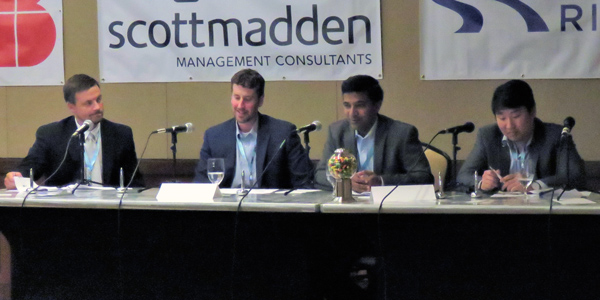By Jason Fordney
SAN DIEGO — The electricity sector continues to identify possible applications for energy storage while costs for the technology steadily decline, but the lack of cohesive federal, state and local policy remains the chief obstacle to integration, a panel of experts said Wednesday.
“The technology piece has caught up. What we cannot afford to do is let the policy drag it down,” Kiran Kumaraswamy of AES Energy Storage said during a panel discussion at the Infocast Transmission Summit West. Industry and policymakers can develop a framework for adopting storage once they determine the magnitude and type of need for the technology, he said.
Storage has not traditionally been seen as a workable solution to solving locational reliability needs on the transmission grid, and there are questions as to whether it should be regulated as a generation or transmission/distribution asset. The U.S., especially CAISO, is in a leadership position as far as deploying storage, “but the rest of the world is catching up,” Kumaraswamy said.
Storage can also defer transmission investment, and “the ISO has been very progressive in considering non-wires alternatives,” he said.
CAISO recently launched a yearslong effort to develop a load-shifting product for energy storage, the third phase of its Energy Storage and Distributed Energy Resources (ESDER) initiative. (See CAISO Load-Shifting Product to Target Energy Storage.)
Even in situations in which conventional generation would be much cheaper, California regulatory policy and public opinion are driving storage applications. After CAISO recently performed a study finding that the $299 million proposed Puente Power Project is the cheapest alternative to energy storage and distributed energy solutions costing up to $1.2 billion, the California Energy Commission still indicated that it might not approve the plant. (See CEC Members Recommend No-Go for Puente Plant.)
There is “a very good working relationship between renewables and energy storage,” according to Tom Dagenais of Duke-American Transmission Co., a joint venture between Duke Energy and American Transmission Co. created to develop new transmission projects — such as the Zephyr line to carry wind energy from Wyoming to California, and the San Luis transmission project in California’s Central Valley.
Dagenais cautioned that integrating energy storage is a challenge, and that the decisions being made today as the technology enters the market will set the tone for how it is perceived in the future.
“If we screw this up, there is going to be a lot of fingers pointed and a lot of questions,” he said.
FERC last November issued a Notice of Proposed Rulemaking that would require each RTO and ISO to recognize the physical and operational characteristics of storage, and accommodate storage and aggregated distributed resources in organized markets. (See FERC Rule Would Boost Energy Storage, DER.)
But the agency lost its quorum shortly after the proposed rule was issued, and it is unclear whether the new commission will act on it. It is also unknown how FERC will view storage as the commission becomes embroiled in controversy over Energy Secretary Rick Perry’s new proposed rule designed to bolster coal-fired generation.
Idaho Public Commissioner Kristine Raper asked the panel how a state like hers, which is long on capacity and has an abundance of hydroelectric generation, could take advantage of energy storage.
Jin Noh of the California Energy Storage Alliance noted that California has sufficient capacity but is still pursuing energy storage. “It is a question of what type of capacity,” Noh said. “There is a major need for flexibility capacity and opportunities to save ratepayer money.”
Dagenais said: “Idaho is in a pretty unique situation,” adding that many other states have a rapidly changing resource mix. He said that storage is still something worth looking into to cut costs and reduce use of lower-efficiency generation units at peak times.





